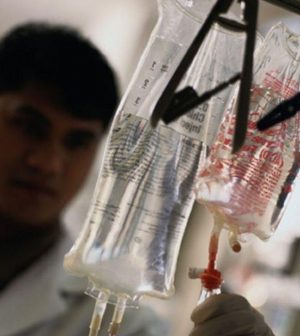- Skip Storing This Everyday Product in the Fridge Door
- Green Tea + B3 Pairing May Boost Brain Health
- Navigating Your Midlife Crisis: Embracing New Possibilities
- City Raccoons Showing Signs of Domestication
- Mapping the Exposome: Science Broadens Focus to Environmental Disease Triggers
- One Week Less on Social Media Linked to Better Mental Health
- Your Brain Changes in Stages as You Age, Study Finds
- Some Suicide Victims Show No Typical Warning Signs, Study Finds
- ByHeart Formula Faces Lawsuits After Babies Sickened With Botulism
- Switch to Vegan Diet Could Cut Your Greenhouse Gas Emissions in Half
Saline IV Drip Just as Good as Pricier Options in Hospital ICUs: Study

Saline intravenous (IV) fluids are as effective as more costly solutions in treating intensive care patients and keeping them alive, Australian researchers report.
“Just about every patient admitted to the intensive care unit (ICU) will receive intravenous fluids for resuscitation or as part of standard treatment,” noted the study’s lead author Dr. Simon Finfer. He’s an ICU physician and senior researcher at The George Institute for Global Health in Newtown, Australia.
“However, the best choice of fluid has been a longstanding issue of debate as some fluids were approved and licensed for use based on trials in small numbers of patients looking only at short-term outcomes,” Finfer said in an institute news release.
The use of more expensive “balanced multielectrolyte solutions” — IV fluid that more closely matches the body’s normal levels of certain minerals — is up amid concerns about increased rates of kidney injury and death associated with saline IVs. This link has not been proven in clinical trials, however.
To learn more, Finfer’s team compared saline with a balanced electrolyte solution (called Plasma-Lyte 148) in more than 5,000 adult ICU patients in Australia and New Zealand.
The investigators compared death rates of patients who received each type of IV solution. At 90 days after treatment, both groups had the same number of deaths.
The number of days patients required mechanical ventilation or kidney dialysis, their survival time in the ICU and the hospital, and major health care costs were similar between the groups, the findings showed.
“We found no evidence that using a balanced multielectrolyte solution in the ICU, compared to saline, reduced risk of death or acute kidney injury in critically ill adults,” Finfer said.
Along with reassuring doctors about the safety and benefits of saline solution, the findings have significant implications in terms of treatment availability and costs, according to the researchers.
In previous studies, they compared saline solution with albumin and hydroxyethyl starch (HES) IV solutions. “We found saline was as good as albumin and better for patients with a traumatic brain injury, and saline had similar outcomes to HES without the associated toxicity,” Finfer noted.
He described the studies as groundbreaking for medical practice around the world.
“Our researchers have changed the way the medical world thinks about intravenous fluids and have demonstrated that the choice of fluid should be treated with the same care and attention as the prescription of any drug,” Finfer said.
The findings were published Jan. 18 in the New England Journal of Medicine.
More information
The U.S. National Library of Medicine has more on intensive care.
SOURCE: The George Institute, news release, Jan. 18, 2022
Source: HealthDay
Copyright © 2025 HealthDay. All rights reserved.










